|
|
|||
|
(Back to Preceding Week; on to Next Week) |
|
MULTIFLORA ROSE:
When people ask us about Hilton Pond Center's mission--"to conserve animals, plants, habitats, and other natural components of the Piedmont Region of the eastern United States through observation, scientific study, and education for students of all ages"--they understand our intent but sometimes ask "What's the Piedmont?" In brief, the Piedmont physiographic province extends from southeastern New York to central Alabama (see map below left), bounded on the east by the Coastal Plain and to the west by the Appalachians and associated mountains.
All text & photos © Hilton Pond Center Multiflora Rose--whose technical epithet of Rosa multiflora is an easy scientific name to remember--is so-called because it produces many flowers in a cluster. (Native roses usually bear individual, unclustered flowers.) This Asian species was introduced from Japan to the eastern U.S. in the mid-1860s as rootstock for less-hardy ornamental roses. Not long afterwards it escaped cultivation, creeping its way up and down the Eastern Seaboard and points west. In the 1930s, its advance accelerated when the Soil Conservation Service began advising farmers to plant Multiflora Rose to retard erosion and even to serve as a "living fence" whose sharp thorns could contain animals as large as cattle and horses. Game agencies extolled the virtues of Multiflora Rose as a source of cover for Eastern Cottontails, Bobwhite, and other birds. (Has there ever been a Multiflora Rose thicket in the Carolinas that despite its impenetrable appearance didn't sooner or later host the nest of a pair of Northern Mockingbirds?)
Like most other members of the Rose Family (Rosaceae), Multiflora Rose has five identical petals--in this case pure white (above)--all arranged around a center filled with a pistil and many pollen-bearing stamens. With such a showy display, one might conclude this species must attract scores of insects, but Multiflora Rose is known to be strongly self-pollinating--assuring that fertilization and fruit production occur with or without a cooperative squadron of bees, flies, and other pollinators.
Multiflora Rose seedlings start out as a single green stalk, or cane, that eventually forms lateral branches. When the main stalk is a year or so old, it begins to turn purplish-brown (above) and develop bark; by then the weight of lateral branches and accompanying foliage and fruit bends the cane in a graceful, downward arch.
Unfortunately, this arch harbors a hidden menace, one that is the bane of humans and wildlife alike: A hard, viciously decurved thorn (above) that can slice an arm, lacerate an ankle, or--in the case of cattle--shred an udder or scrotum so savagely the cow or bull dies from shock or infection. The curve of a Multiflora Rose thorn is toward the base of the cane, so a person brushing against the shrub is instantly impaled; moving forward merely drives the thorn deeper into one's skin or lengthens the scratch. During a less severe encounter--one in which a body merely bumps the cane--the thorn tip often breaks off in the skin, festering a day or two later. (Some people even have an allergic reaction to rose thorn scratches.) 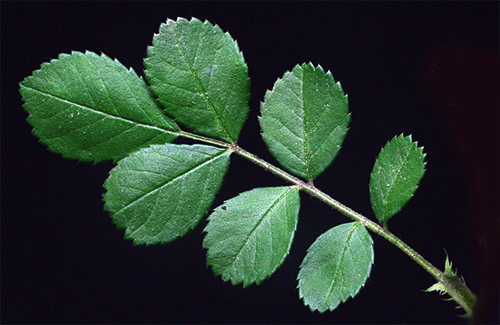 The canes of Multiflora Rose produce pinnately compound leaves (above), each with 5-11 serrated, oval leaflets with slightly hairy undersides. The leaf petiole--the structure that attaches it to the stem--bears a pair of fringed bracts at its base. (In native roses these stipules are not usually feathery.)
Not that having heavy thorns on its canes isn't enough, the leaves of Multiflora Rose are also armored--each with several tiny eighth-inch-long hooks. These aren't so stout, but they can still grab clothing or skin and pull the cane close enough so bigger thorns can dig in. We distinctly remember our first encounter, at age 10, with Multiflora Rose. On a family trip from Pittsburgh to visit grandparents in the Carolina Piedmont, we were playing catch in a yard bordered by rambling Multiflora Rose bushes. As we chased a ball over our head, we tried to jump a low-lying rose but caught our shoe on some of its prickly leaves. We shrieked in pain as the cane whipped around our leg and its thorns raked the inside of our left knee--leaving four parallel bloody lines that remain as telltale scars more than 50 years later.
The worst thing about Multiflora Rose is it's an attractive plant, with a multitude of breathtaking white blossoms that stand out against dark green foliage when May arrives. (Native roses usually have pinkish flowers, while Multiflora Rose rarely does.) It seems a pity to dislike a plant so pleasing to the eye, but we do all we can to whack back every non-native rose can we can at Hilton Pond Center. Despite our efforts, each spring we always seem to find another Multiflora Rose bush or, worse yet, a mature old two-inch-diameter cane--brown and covered with flaking bark--that has sneaked and snaked its way up a supportive tree trunk to make foliage and flowers 20 feet or more from the ground. Cutting this stem at its base kills what we can see, but the next spring we typically find numerous new canes sprouting from the rootstock. We could apply herbicide to the freshly cut stem, but our preference is to prune the sprouts year after year before they flower and until the mother plant finally dies. Multiflora Rose--invasive, painful to encounter, and hard to get rid of, but delightful to look at and useful for wildlife. To kill, or not? Here in the Carolina Piedmont, it's a thorny problem indeed.
All text & photos © Hilton Pond Center POSTSCRIPT #1: Good friend Jim Shuman reminds us of something we learned together eons ago from the great West Virginia botanist Earl Core: Multiflora Rose is actually a prickly problem, not a thorny problem. A "thorn" is a modified stem of a woody plant, such as in Buckthorn or Barberry. A "prickle" is a pointed outgrowth of a plant's epidermis, as in any rose. You can tell the difference by determining how the pointed part of a plant breaks off. A thorn doesn't snap off easily, in the same way it is difficult to break a small branch from a living tree or shrub due to the stringy nature of a plant's woody core. A prickle snaps off with relative ease--often fully intact--leaving only an open scar where its base was attached to the plant's skin. Incidentally, "spines"--as in cacti--are actually modified leaves. POSTSCRIPT #2: Outdoor writer Jim Casada makes an interesting point about the value of Multiflora Rose for wildlife: Two of the species it was supposed to help most, Bobwhites and cottontails, have declined dramatically in the years since planting the rose was so staunchly advocated. Of course, there is a whole host of reasons--mostly revolving around habitat--for the decline. Nonetheless, multiflora obviously did little to help the bunnies and the quail.
Comments or questions about this week's installment?
Thanks to the following fine folks for recent gifts in support of Hilton Pond Center for Piedmont Natural History and/or Operation RubyThroat: The Hummingbird Project. Your tax-deductible contributions allow us to continue writing, photographing, and sharing "This Week at Hilton Pond." (Please see Support if you'd like to make a gift of your own.)
"This Week at Hilton Pond" is written & photographed You may wish to consult our Index of all nature topics covered since February 2000. You can also use our on-line Hilton Pond Search Engine at the bottom of this page. For a free, non-fattening, on-line subscription to |
|
Make direct donations on-line via
Network for Good: |
|
|
Use your PayPal account
to make direct donations: |
|
|
If you like to shop on-line, you please become a member of iGive, through which more than 700 on-line stores from Barnes & Noble to Lands' End will donate a percentage of your purchase price in support of Hilton Pond Center and Operation RubyThroat. For every new member who signs up and makes an on-line purchase iGive will donate an ADDITIONAL $5 to the Center. Please sign up by going to the iGive Web site; more than 150 members have signed up to help. It's a painless, important way for YOU to support our work in conservation, education, and research. |
|
| The highly coveted Operation RubyThroat T-shirt (four-color silk-screened) is made of top-quality 100% white cotton. It highlights the Operation RubyThroat logo on the front and the project's Web address (www.rubythroat.org) across the back.
Now you can wear this unique shirt AND help support Operation RubyThroat: The Hummingbird Project and Hilton Pond Center. Be sure to let us know your mailing address and adult shirt size: Small (suitable for children), Medium, Large, X-Large, or XX-Large. These quality shirts don't shrink! Price ($21.50) includes U.S. shipping. A major gift of $1,000 gets you two Special Edition T-shirts with "Major Donor" on the sleeve. |
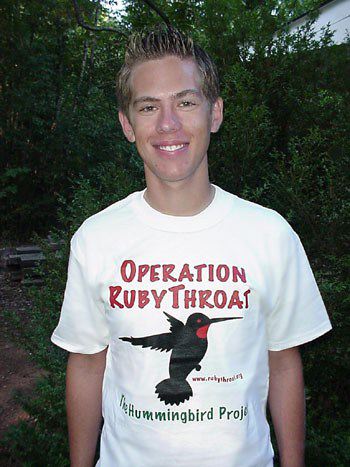
Need a Special Gift for a Want to make a If so, why not use our new handy-dandy on-line Google Checkout below to place your secure credit card order or become a Major Donor today? |
|
|
|
|
SPECIES BANDED THIS WEEK: * = New species for 2008 WEEKLY BANDING TOTAL 19 species 37 individuals YEARLY BANDING TOTAL (2008) 35 species 861 individuals 27-YEAR BANDING GRAND TOTAL (since 28 June 1982) 124 species 51,028 individuals NOTABLE RECAPTURES THIS WEEK (with original banding date, sex, and current age) American Goldfinch (3) Carolina Chickadee (3) Northern Cardinal (3) Great Crested Flycatcher (1) Summer Tanager (1) Carolina Wren (1) White-throated Sparrow (1) Tufted Titmouse (4)
|
OTHER NATURE NOTES OF INTEREST --Due to our regular gig as lecturer, field trip leader, and bander-in-residence at the annual New River Birding & Nature Festival in Fayette County WV, we were gone from Hilton Pond Center 4-10 May and undoubtedly missed quite a few migrants passing through our home turf. Nonetheless, on days we were around to run mist nets we had numerous species--some rather uncommon (see list at left). Included was our 71st Chestnut-sided Warbler since 1982, our 63rd House Wren AND 63rd Blue Grosbeak, plus a rather late White-throated Sparrow (1 May) and Yellow-rumped Warbler (3 May). --Along with the Multiflora Rose described in the photo essay above, the flowers of another foreign plant--Chinese Privet--were filling the air around Hilton Pond with indescribably sweet fragrance, and Japanese Honeysuckle was trying mightily to compete for best spring odor. When we smell all these non-natives we're almost-but-not-quite-ready to forget they're invasive plants that crowd out native species and play havoc with natural succession. --This week's recaptured birds of particular interest include two Neotropical migrants: An after 5th year Great Crested Flycatcher banded in 2004, and a Summer Tanager captured last year. These birds undoubtedly have been to the Central or South America and came right back to Hilton Pond Center, an always amazing migrational/navigational feat. --Ahem. In case you missed the note at the top of the page, we pleased to announce the current installment of "This Week at Hilton Pond" is our 400th since we began this venture on Groundhog Day back in 2000. All past photo essays are archived and accessible by title from the Index, or by entering keywords into the on-site Search Engine available on every page of the Hilton Pond Web site. (We humbly admit that many of our early essays were far too short and contained too few photos, but we're trying harder.)
|
|
|
|
(Back to Preceding Week; on to Next Week) Up to Top of Page Back to This Week at Hilton Pond Center Current Weather Conditions at Hilton Pond Center |
 You can also post questions for The Piedmont Naturalist |
Join the |
Search Engine for |
|
|
Vista Print.com

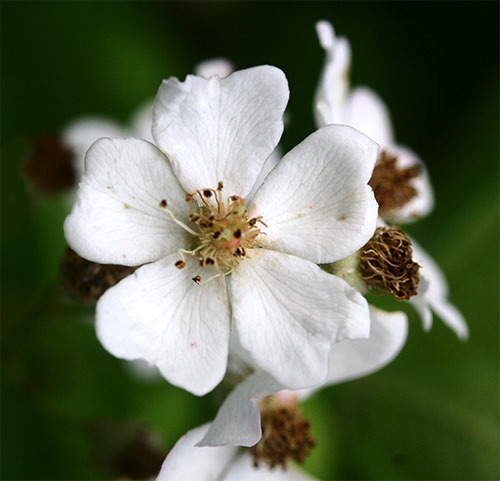
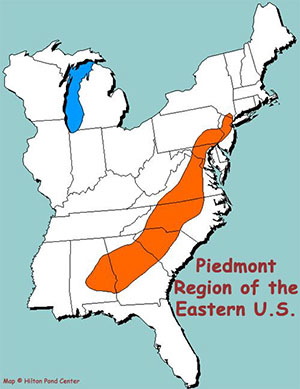 As a region the Piedmont is marked by rolling hills, by lots of rivers and streams, and--at least in its southeastern sections--by expanses of red clay. The latter arose primarily from weathering of subsoil exposed when substantial topsoil above it was depleted or eroded away due to poor farming practices. Indeed, the Piedmont has been the most heavily abused ecosystem in the eastern U.S. because it was such a great place for agriculture; farms and towns that sprang up within the Piedmont also made it the most heavily fragmented. In recent years, many Piedmont farmsteads have been abandoned, sometimes overrun by towns and cities but often just allowed to revert to a more natural state. Although the resulting vegetational succession should be good news, 200-plus years of row crops and grazing not only depleted Piedmont soil but eliminated seeds and rootstocks of many native plants. Under such conditions, what often flourished on old farms and spoil places were invasive foreign plants that in marginal habitats could actually out-compete native species. It's nice to have plant life that thrives in unused Piedmont landscape, but when those plants are the likes of Multiflora Rose, we're presented with a very thorny problem.
As a region the Piedmont is marked by rolling hills, by lots of rivers and streams, and--at least in its southeastern sections--by expanses of red clay. The latter arose primarily from weathering of subsoil exposed when substantial topsoil above it was depleted or eroded away due to poor farming practices. Indeed, the Piedmont has been the most heavily abused ecosystem in the eastern U.S. because it was such a great place for agriculture; farms and towns that sprang up within the Piedmont also made it the most heavily fragmented. In recent years, many Piedmont farmsteads have been abandoned, sometimes overrun by towns and cities but often just allowed to revert to a more natural state. Although the resulting vegetational succession should be good news, 200-plus years of row crops and grazing not only depleted Piedmont soil but eliminated seeds and rootstocks of many native plants. Under such conditions, what often flourished on old farms and spoil places were invasive foreign plants that in marginal habitats could actually out-compete native species. It's nice to have plant life that thrives in unused Piedmont landscape, but when those plants are the likes of Multiflora Rose, we're presented with a very thorny problem.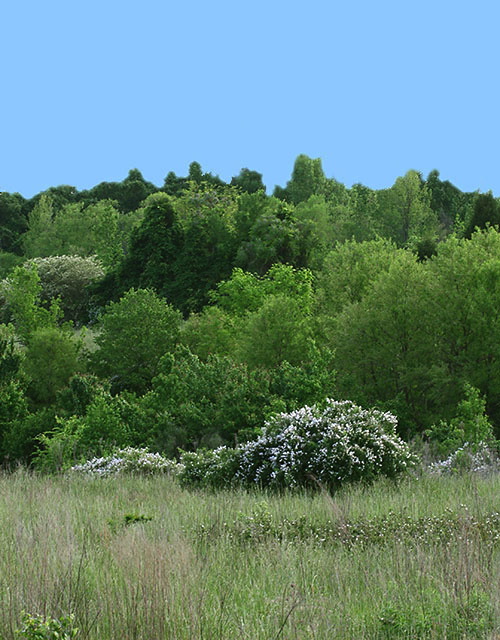
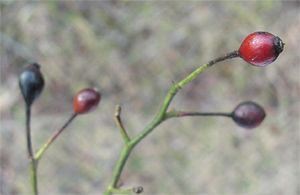 In addition to providing shelter, red rose hips about a quarter-inch round (right) were touted as excellent cold-weather food for everything from White-footed Mice to White-tailed Deer. Birds also like rose hips as a late-winter snack high in Vitamin C, but one problem is the fruits are loaded with seeds whose germination success is enhanced if they pass through a bird and are deposited in its droppings. And because Multiflora Rose also propagates by runners AND by sprouting where its long, arching canes touch the ground, it doesn't take long for a single rose shrub to produce a plethora of progeny both near and far. In fact, it's not uncommon here in the Carolina Piedmont to see an old pasture (top photo) almost completely covered by a near-monoculture of Multiflora Rose, each plant capable each year of producing thousands of flowers (below) and a million or more seeds--some of which will be viable in the soil for up to two decades! It's no wonder the species is now found almost everywhere in the continental U.S. and Canada except for the Rocky Mountain region.
In addition to providing shelter, red rose hips about a quarter-inch round (right) were touted as excellent cold-weather food for everything from White-footed Mice to White-tailed Deer. Birds also like rose hips as a late-winter snack high in Vitamin C, but one problem is the fruits are loaded with seeds whose germination success is enhanced if they pass through a bird and are deposited in its droppings. And because Multiflora Rose also propagates by runners AND by sprouting where its long, arching canes touch the ground, it doesn't take long for a single rose shrub to produce a plethora of progeny both near and far. In fact, it's not uncommon here in the Carolina Piedmont to see an old pasture (top photo) almost completely covered by a near-monoculture of Multiflora Rose, each plant capable each year of producing thousands of flowers (below) and a million or more seeds--some of which will be viable in the soil for up to two decades! It's no wonder the species is now found almost everywhere in the continental U.S. and Canada except for the Rocky Mountain region.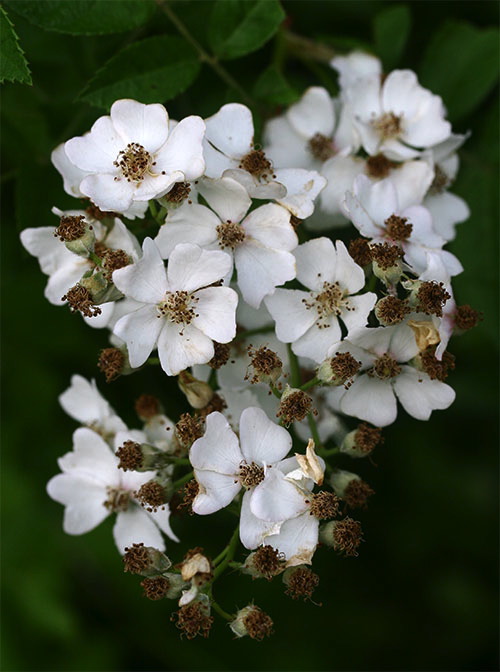

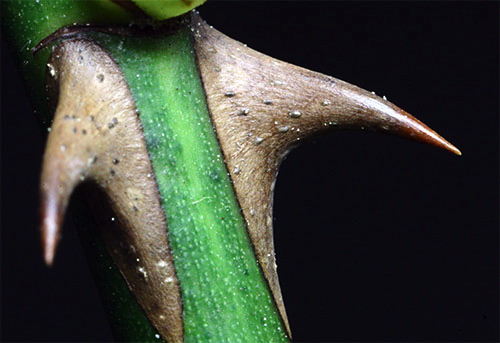
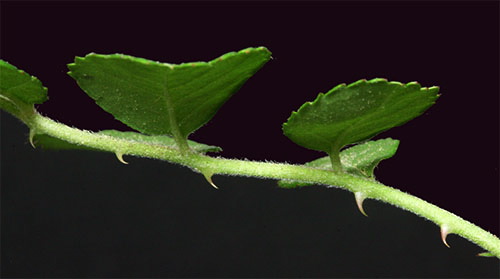
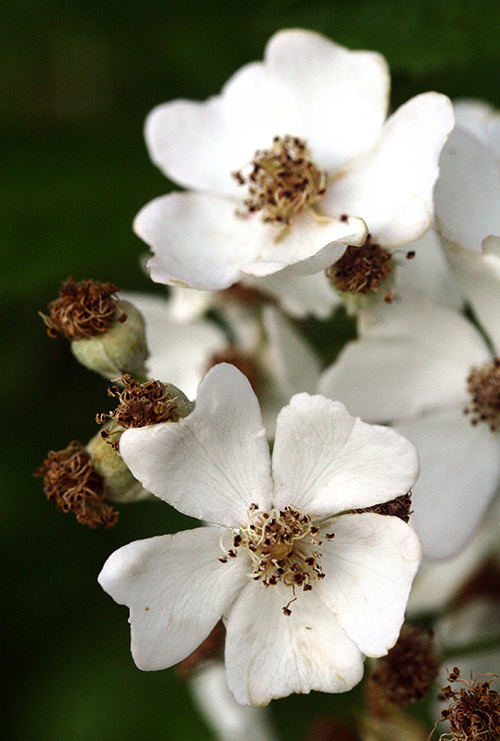


 Please report your
Please report your